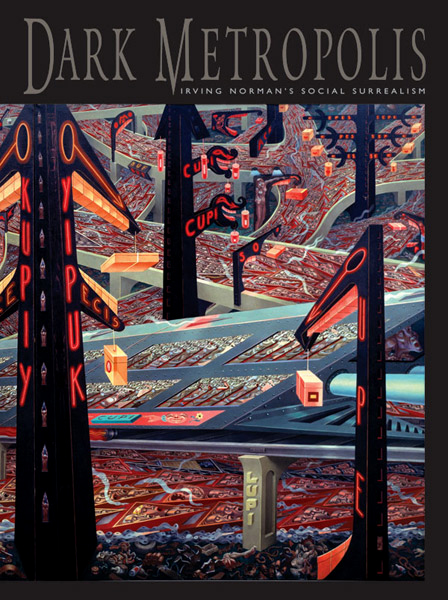| Dark Metropolis Irving Norman’s Social Surrealism |
Crocker Art Museum and Irving Norman Trust
Edited by Ray Day and Scott A. Shields |
| Colorful and provocative art with a social conscience |
An émigré from Poland who survived World War I as a child and witnessed atrocities as a machine gunner in the Abraham Lincoln Brigade of the Spanish Civil War, Irving Norman (1906–1989) painted with a dark vision at once personal and prophetic. Writing in Art in America ( July 2003) Michael Duncan described his paintings as “jaw-droppingly effective social indictments that would have been endorsed by Orwell and Huxley. The unrestrained passion and monumental energy of this work blows most contemporary political art out of the water.”
Norman’s massive canvases abound with teeming figures, drone-like and mechanical in their repetition, yet stubbornly and hauntingly human.The combination of jewel-tone colors, transcendent messages, and technical virtuosity make his work unique in the history of American art. Dark Metropolis, a book of compelling vision, is being produced in conjunction with the Crocker Art Museum in Sacramento to accompany an ambitious retrospective of the art of this important painter.
|
| For twenty-six years, Ray Day has been involved in documentary film productions for television. He graduated in 1979 with an MFA from the University of South Florida. |
| Scott A. Shields is the Chief Curator at the Crocker Art Museum in Sacramento. He has written numerous scholarly articles on modern and contemporary art and is the editor of San Francisco and the Second Wave: The Blair Collection of Bay Area Abstract Expressionism and the author of Artists at Continent’s End: The Monterey Peninsula Art Colony, 1875–1907. |
| Order through Amazon.com! |
| Trade Paper, ISBN: 1-59714-041-4, $26.00 (as of July, 2011) |
| 223 pages (9 x 12), with 154 color plates |
| With essays by Michael Duncan, Charles C. Eldredge, Patricia Junker, and Scott A. Shields |

